Laboratory products
How AI Vision becomes easily accessible
Nov 01 2022
Industrial cameras with artificial intelligence are more than just image providers. They can, for example, recognise different objects, generate results themselves or even trigger tracking processes in networked systems. This opens up completely new application possibilities for image processing across all industries.
AI-based cameras show their strengths especially when it comes to recognising a wide variety of organic shapes, locating randomly distributed objects in complex images and detecting anomalies. These intelligent image processing solutions are attracting a lot of interest on the market, but in comparison, AI vision is still relatively rarely evaluated and used.
What could be the reason for this? In a recent Bitkom survey, one in two respondents said that they do not use AI in the enterprise for fear of programming errors and lack of controllability. With IDS NXT (www.ids-nxt.com), IDS Imaging Development Systems GmbH has developed a complete AI vision system that not only brings the technology to the forefront, but also focuses on the user-friendliness and traceability of AI decisions.
The company regularly provides free updates with new features. Anyone who wants to better understand the basis on which the AI makes decisions will be pleased with the new Attention Maps (heatmaps) in the AI Vision Studio IDS NXT lighthouse. They make it visually comprehensible which image areas play a role for the inference result and are therefore suitable for quality control or the targeted retraining of a neural network.
IDS NXT is a comprehensive system with multiple workflows and tools to realise individual and highly flexible AI vision applications. IDS NXT cameras can process tasks “on-device” and provide image processing results themselves. The camera tasks are determined by vision apps that can be created with the help of the AI Vision Studio and run directly on the cameras. Their functionality can therefore be changed at any time. Software such as IDS NXT lighthouse, which not only allows users to train in neural networks, but also to create their own vision applications, supports this task.
Users benefit from tools such as the new "Use Case Assistant", which guides the user through the creation of a vision app, and the recently introduced block-based editor. With predefined functions in the form of blocks, users can design their individual sequences with AI image processing, such as object recognition or classification, without programming knowledge. This ranges, for example, from a simple application framework for evaluating camera images in a programme loop, to the use of variables, to browsing image processing results and signalling to external clients. The system offers both beginners and professionals enormous possibilities for creating AI vision applications.
Digital Edition
Lab Asia 31.6 Dec 2024
December 2024
Chromatography Articles - Sustainable chromatography: Embracing software for greener methods Mass Spectrometry & Spectroscopy Articles - Solving industry challenges for phosphorus containi...
View all digital editions
Events
Jan 22 2025 Tokyo, Japan
Jan 22 2025 Birmingham, UK
Jan 25 2025 San Diego, CA, USA
Jan 27 2025 Dubai, UAE
Jan 29 2025 Tokyo, Japan



.jpg)

















